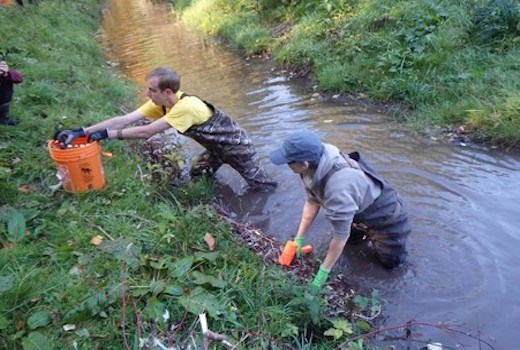NEWS RELEASE
NOTTAWASAGA VALLEY CONSERVATION AUTHORITY
*************************
UTOPIA - The Nottawasaga Valley Conservation Authority (NVCA) received a $100,000 boost for its Healthy Waters stewardship program from Environment and Climate Change Canada’s EcoAction program.
The 2020 Vision of Healthy Waters project runs from 2017-2020. NVCA will make grants available to landowners, farmers and community groups for on-the-ground projects to improve water quality, restore aquatic and wildlife habitat, and build climate change resilience in “green infrastructure.”
With the help of residents and volunteers, the new funding will support planting 22 ha of native trees and shrubs; reduce 20 kg of phosphorus runoff to rivers and lakes, and 50 tonnes of soil erosion; protect and restore 1.9 ha of globally significant wetland habitat; enhance 1.7 km of impaired rivers; and install habitat structures like bird boxes and turtle basking logs.
“This is good news for our landowners and community groups in the Nottawasaga Valley that want to help improve habitat and water quality! Thanks to the Eco Action program funding, we’ll be able to fund more projects that make for a great place to live – with cleaner, swimmable, drinkable water all of us, including the fish,” said Shannon Stephens, NVCA’s Healthy Waters program coordinator.
“Over the years we’ve worked with thousands of farmers, rural and urban landowners and volunteers to tangibly improve the environment we all live in,” added Ms. Stephens. “We can’t wait to continue this work.”
Healthy Waters program grants
Landowners, farmers and community groups are encouraged to apply for Healthy Waters program grants to support their stewardship projects. Grant rates range from 30 – 100 per cent for eligible projects, which include:
- Tree planting along streams and lakes with native trees and shrubs
- Lowering the impact of on-stream ponds through decommissioning, stream bypasses, dam bottom-draws and fishways
- High priority stream rehabilitation
- Keeping livestock out of waterways and wetlands (fencing and associated alternate watering sources, and livestock stream crossings)
- Clean water diversion (barn eaves, berms to reduce runoff volume)
- Manure storages
- Runoff treatment (treatment wetlands, vegetated filter strips, etc.)
- Nutrient Management Plans/Strategy
- Improving fuel, chemical and pesticide storage
- Advanced treatment septic system upgrades (within 30 m of waterbody)
- Well decommissioning
Note that projects must be located in the Nottawasaga Valley watershed, and must be pre-approved; those completed prior to approval are not eligible for grants.
In addition, no-cost technical project assistance, including site visits, are available to those interested in learning more about restoring and enhancing their property.
Not a landowner, but want to help? Every year, thousands of volunteers get down-and-dirty helping restore the environment.
To learn more about the grant program or volunteering, call Shannon Stephens at the NVCA, 705-424-1479 ext. 239, or visit the website and search “Healthy Waters Program.”
Building Natural Resilience to a Changing Climate
One of the key focuses of the “2020 Vision of Healthy Waters” project is to mitigate and adapt to climate change. In the Nottawasaga Valley, we are lucky to have beautiful cold-water trout and salmon streams. But a warming climate puts these fisheries at risk. For example, native brook trout can only survive if stream temperatures are under 24 C.
Planting trees and shrubs is a key way to build resilience to our changing climate. Not only do streamside trees store carbon and shade cold-water streams, they stabilize stream banks against erosion during high water flows.
Stewardship projects that reduce nutrient runoff, like agricultural erosion control and fencing livestock out of waterways, also build climate resilience, as warmer, nutrient-rich water is more likely to have algae blooms.
The Healthy Waters program grants can be accessed for both streamside tree planting and programs to reduce runoff.
The grants also cover improvements to on-stream dams. Past NCVA stewardship projects show that even a small dam can raise downstream temperatures by 4 C to 6 C – to the point that native fish are unable to survive. But this can be reduced through stream bypasses, pond bottom-draws and dam decommissioning.
*************************



